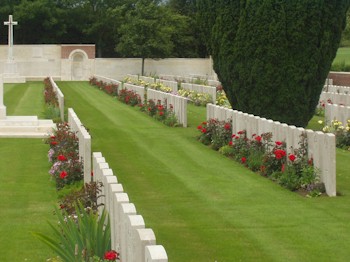|
|
| Home Topics Memorials Miscellany Transcripts References Family History Glossary Latest Beeston Blog About us | Site Search |
|
Ernest attended the Nether School where he started on 29th August 19043, leaving on 7th October 1910 to begin employment as an apprentice at the Co-op Grocery Stores in Beeston. Samuel went through his years in the Boys Brigade and continued his membership in the Beeston Old Boys. He was a keen footballer and played for the Lenton Priory Football team. He along with an old school and "BB" friend Bernard Spray enlisted together at a Recruiting Office in Nottingham joining the Kings Royal Rifles in December 1914. The 10th Battalion King’s Royal Rifle Corps were formed at Winchester as one of Kitchener’s new Service Battalions. While in the town of Blackdown, Leamington Spa in Warwickshire, the battalion became part of the 59th Brigade, 20 Division along with their sister battalion the 11th KRRC. In April 1915 we see the battalion in Whitley, transferring in April 1915 to Hamilton Camp, near Stonehenge. The Division was inspected by King George V at Knighton Down on 24 June 1915, by which time all equipment had arrived and the Division was judged ready for war. The Battalion sailed for France landing at Boulogne on 21st July 1915. This is how the local paper described his loss:"From shop-man in a local stores at Beeston to a machine gunner on a modern battle field is a big transformation and to go through a series of terrible battles with comparitable slight injuries is another yet remarkable episode in the career of a young man who would have been only 20 years old next month. He had been in France about 2 years when he was killed in action. Private Tonks had taken part in most of the big battles in his sector of the war camps. Rifleman Tonks died of wounds on 20th June 1917 and is buried along with 28 others of 10th King’s Royal Rifle Corps in Grevillers British Cemetery. Grevillers British Cemetery - The village of Grevillers was occupied by Commonwealth troops on 14 March 1917 and in April and May, the 3rd, 29th and 3rd Australian Casualty Clearing Stations were posted nearby. They began the cemetery and continued to use it until March 1918, when Grevillers was lost to the Germans during their great spring advance. On the following 24 August, the New Zealand Division recaptured Grevillers and in September, the 34th, 49th and 56th Casualty Clearing Stations came to the village and used the cemetery again. After the Armistice, 200 graves were brought in from the battlefields to the south of the village, and 40 from an adjoining cemetery made during the German occupation, which no longer exists. Commonwealth graves from the following cemeteries were concentrated into this site:- Avesnes-Les-Bapaume German Cemetery, "near the British huts", contained the graves of two soldiers from the United Kingdom who died in April, 1918. Bayonet Trench Cemetery Guedecourt, contained the graves of 19 soldiers of the 1st Australian Infantry Battalion who fell on the 5th November, 1916. There are now 2,106 Commonwealth servicemen of the First World War buried or commemorated in Grevillers British Cemetery. 189 of the burials are unidentified but there are special memorials to 18 casualties known or believed to be buried among them. Other special memorials record the names of two casualties, buried in Avesnes-les-Bapaume German Cemetery, whose graves could not be found. The cemetery also contains the graves of seven Second World War airmen, and 18 French war graves. Within the cemetery stands the Grevillers (New Zeland) Memorial which commemorates almost 450 officers and men of the New Zealand Division who died in the defensive fighting in the area from March to August 1918, and in the Advance to Victory between 8 August and 11 November 1918, and who have no known grave. This is one of seven memorials in France and Belgium to those New Zealand soldiers who died on the Western Front and whose graves are not known. The memorials are all in cemeteries chosen as appropriate to the fighting in which the men died. The cemetery and memorial were designed by Sir Edwin Lutyens.4 Footnotes 1The photograph of Grevillers British Cemetery is from the Commonwealth War Graves Commission website. (http://www.cwgc.org) 21901 Census Piece 3153, Folio 109. Half-brother William, age 20, was working as a moulder in the foundry while John (17) and Arthur (14) were working in a cycle works (probably Humbers) as a filer and turner respectively. At the time of Ernest's death, the family were living at 21 Clifton Street, Beeston (the address given in the Commonweath War Graves Commission records). 3He was recorded as number 3475 in the School Admissions Register. 4This decription of Grevillers British Cemetery is based on that given on the Commonwealth War Graves Commission website. (http://www.cwgc.org) |
|
|||||||||||
|
|
|||||||||||||

 Ernest Samuel Tonks was born in Beeston on the 26th June 1897, the son of Sam Tonks (born about 1860 in Radford, Notts) and his wife Elizabeth (née Cross,
b. 1859, Beeston Notts). Sam was a lace maker who had married Elizabeth in 1896, after previously being married to Anne (née Chamberlain) who had died in
1892. In 1901, the family - including Ernest's three older half-brothers, were living at 30 Willoughby Street, Beeston2. It appears that Ernest
was his mother's only child.
Ernest Samuel Tonks was born in Beeston on the 26th June 1897, the son of Sam Tonks (born about 1860 in Radford, Notts) and his wife Elizabeth (née Cross,
b. 1859, Beeston Notts). Sam was a lace maker who had married Elizabeth in 1896, after previously being married to Anne (née Chamberlain) who had died in
1892. In 1901, the family - including Ernest's three older half-brothers, were living at 30 Willoughby Street, Beeston2. It appears that Ernest
was his mother's only child.